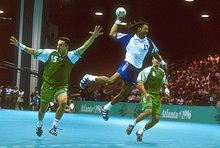Many coaches mean - and not wrongly - that the players must get used to free passes and free pattern of movements at once, where the simple basic rules regarding running in front or behind are kept.
LEARNING:
However it is more easy for the players to understand the basic running lanes and passing possibilities, if they in the start (the first lessons) for instance by training in running in front and behind separately. During this the coach must make the basic rules clear. The players must lean the different possibilities regarding playing and passing by using an established (dictated) training course.
IMPORTANT:
This way of training must only be used in the learning phase or if the coach will teach the team a certain playing system, which suits the team.
UNDERSTANDING THE TRAINING:
It is important that both the coach and the players understand the idea with basic training and they are comfortable with the exercises.The basic play is exercises and ball exercises, where the players have the best conditions to train those passings, which are most natural (and by this also the best) to use in the attack play.
When the players (by training) become familiar with basic lanes and passing forms in the basic exercises, a greater speed and better rhythm in the play is obtained.
The result is that the players freely start to use the different passes, movement and running lanes in the attack play, when the situations occurs (at first during training and later in the match). This will give better chances for scoring, because the combinations will be performed faster, more secure and more confusing for the defense.
At the same time good play and shooting possibilities in the single situation occurs. The different basic play exercises are performed in a training circle. That means that ball- and maybe also player circulation is done without shooting. This causes a lot of repetitions of throwing, catching and running within a short time for all the players. A good way of training. Therefore remember: All effective training is in principle built on a lot of repetition. This gives a faster and greater learning effect.
Intention with the training:
It is also important that the coach and players understand, that it is not the intention, that the players - in the attack play - must feel themselves tied up to the basic movement and passing patterns.
In common the free attack play is build upon the piston movement, where the players play their own position. That means they have their own place during a 3-3 or 4-2 attack.
When a player opens/start an attack to obtain a scoring chance for herself or team-mates by using feints, running in, cross etc then the team-mates join the attack by crossing, screening and more, because they have experienced the movements during the basic training. If the scoring chance does not occur, the rhythm of the play is changed and by using free ball and player circulation, the reposition themselves and are ready for a new attack. If a scoring chance occurs while doing this, it is up to the players to use it.
REMEMBER:
It is quite common that the players only use a few consecutive combinations from the basic training , when they try to bring themselves into a shooting solution.
The basic play training must therefore be a natural part in the training. This is well used during warming up.
Make the players get used to train the exercises, which match their skill. Then the team will get used to use the combinations and passings from the basic training in their free play during a season, which again will give a more "chance creating" play.
BASIC RULES IN THE BASIC PLAYING EXERCISE DRAWINGS:
- The exercises normally starts with the ball/pass on the wings.
- The passes must be placed against/in front of the receiving player, while she is oriented against the ball and so early that she is able to react and catch the ball. This gives security in the play.Note: Backward passing can be trained later.
- A player running in (in front/behind) always runs all the way to the opposite back or wing.
- The wing players basic position is where the free-throw line and the sideline meets, and a running in player always runs between the goal circle and wing player.
- The wing players starts her running in (in front/behind) after having received the ball, and normally runs in after the pass
- The passing sequences are shown on the drawings, and is mostly from left wing to right wing and then reversed. This is valid for all running in exercises (in front/behind).
- The way of passing, which is suitable in the training exercises are normally for right handed players. Left handed players do the same in the opposite direction
- The rear court players must get used to the correct movements such as piston movement, crossings and so on, in the different combinations in order that the rhythm of the training is ideal.
- It is of great importance for the players (especially youth) that they learn all the positions while training. That means that they won't be tied to a certain position.Please do let the players during training get used to all the positions, so they will be comfortable with all the positions, passings and running lanes.
- If more players attend the training that the players, who are needed to 2 training teams (1 team at each goal) following possibilities can be used:
a - Use 2 players on some of the positions in the basic training. Those players take turns.
b - "Waiting players" are used on the positions and comes into action after - for instance - 3 training passes
c - An extra circle is made by cones at the center line of the court, which gives the possibility of 3 training teams. (works fine)
Article extracted from http://dragoerhb.dk/e_index.html






No comments:
Post a Comment